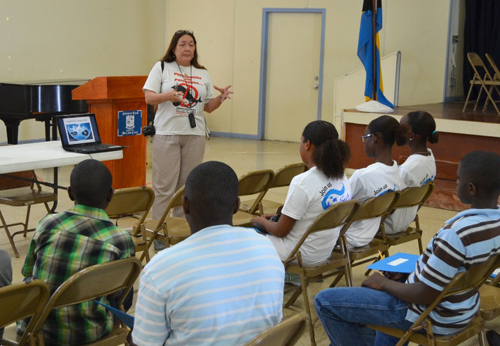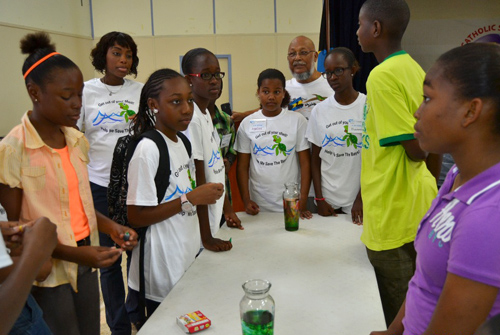
Gail Woon, Founder EARTHCARE and Save the Bays talks about pollution to participants (Photo: Rasheda Ingraham)
|
The EARTHCARE/Save the Bays Saturday Environmental Education Programme continued on February 8th, 2014. Students from various schools on Grand Bahama gathered in the Mary Star of the Sea Auditorium to learn about three types of Pollution: Air, Water and Ground. Gail Woon, Founder of EARTHCARE and a director of Save the Bays gave the students an overview of Pollution and its ramifications for our country.
"Pollution is a very serious problem in the Bahamas. With the porous nature of our ground, when pollutants are dumped on the ground they seep into the limestone substrate and into the freshwater lens that is used for drinking water."
"Air pollution is an issue as well. Fortunately we have steady winds and much of the air pollution is moved. The unfortunate thing is that our air pollution contributes to climate change which will eventually have very detrimental effect s on our Bahamian islands, such as sea level rise. In places like Nassau, and Pinder’s Point on Grand Bahama the air pollution can be so bad at times that people suffer ill health effects such as asthma, breathing difficulties and other adverse health effects such as cancer. Water pollution is a huge issue especially now that we have oil exploration looming on our doorstep."
"We have oil spills regularly. I have had reports of sweetwater trucks dumping raw sewage into the canals of Grand Bahama at night in years past. Runoff from the land also contributes to polluting our waters. This runoff can include the chemicals used in inorganic fertilizers from farms and golf courses. A good example of where NOT to build a golf course, is Baker’s Bay. The coral reef scientists predicted that the nitrates and phosphates running off from the golf course on the beach, would cause eutrophication. The algae that are indicators of nutrient pollution are proliferating now in the shallow water on the beach by the golf course at Baker’s Bay,” said Gail Woon.
Rashema Ingraham, Youth Environment Ambassador Facilitator and Saturday Programme Administrator, led the group in hands on activities to illustrate the effects of pollution on our environment, leading the students in a lively, animated discussion. Following this engaging activity, students were taken by bus to the State of the Art Landfill on Grand Bahama Highway. Jason Albury, Manager of the Pine Ridge Landfill, graciously led a tour of the facility which is a model for the Caribbean region. Vehicle tires are shredded, the shreds are sent to be recycled into new materials such as asphalt. Oil is recycled at the Landfill. Jason explained how the landfill cells are set up and operated. The Landfill is lined by 3 layers of protection to keep the wastes deposited from leaking into the water table. Liquid leachate (“garbage juice”) is drawn off and evaporated in a collecting pool. Methane gas is removed from the landfill and burned. Students were given the opportunity to look through a viewfinder to see the methane flame. The students were amazed at the lack of smell. Our landfill is the “State of the Art” for not just the Bahamas but the entire region. There are 2 fish ponds at the entrance and goats graze the perimeter of the property. The students were very enthused after this part of the field trip.

Rashema Ingraham YEA Facilitator conducts pollution activity with students while Joseph Darville looks on (Photo: Jensen Farquharson)
|
Joe Darville, Education Director for Save the Bays, remarked, “Another day of joy and celebration working with our Youth Environmental Ambassadors, as we opened their eyes, awareness and hearts to additional aspects of our delicate environment which need repair, protection and conservation. The visit to the Freeport Landfill site was impressive in many ways, the extent of the operation, its meticulous management, the state of the art manner in which every type of disposal is delicately handled. That facility, the only one of its kind in this region should be the model for the entire Caribbean area, including Nassau and our family of islands. We congratulate the Grand Bahama Port Authority for establishing such a modern waste management system. Its dedicated, learned and professional staff members deserves the highest adulation. It was indeed a shining example for our young ambassadors to admire how that plan, operates in full harmony with the environment, in a symbiotic and sustainable manner
,” said Darville.
Our young people had another eye-opening experience as they toured the areas around the industrial companies, where they were meticulously informed of past, present and on-going problems related to air, water and ground pollution. The historical reasons for the removal of schools from that area, as well as the critical necessity now to relocate all residents from the surrounding communities, left an indelible impression on them.
Nikie Severe, Youth Environment Ambassador Facilitator, Joseph Darville, Education Director of Save the Bays and Jensen Farquharson, Youth Environment Ambassador Facilitator gave the students an education about the history of the Pinder’s Point Area as it relates to Pollution issues. Nikie grew up in Pinder’s Point and explained her experiences and why she is dedicated to teaching the public about the dangers and consequences of pollution on our island.
Solutions: Do not dump pollutants on the ground. Educate persons about pollution. Keep your car tuned so that it does not emit noxious fumes that will contribute to climate change. Report to authorities if you see an industry creating excessive air/water or ground pollution. Report situations where the water is polluted by oil or other chemicals. Sign the Save the Bays Petition to put Environmental Protection legislation in place so that there will be stiff penalties if a polluter pollutes.
The next session of the EARTHCARE/Save the Bays Saturday Environmental Education Programme meets on February 22nd
Contact: "Joseph Darville" jdarville3003@hotmail.com

Jason Albury of Sanitation Services explains the methane flame to YEA students. (Photo: Rasheda Ingraham)
|
